|

 Up
Up 
 Who was first?
Who was first?

(You are here.)
 Down
Down




  Need
to Need
to
find your
bearings?
Try
these
navigation aids:
If
this is your first
visit, please stop by:
Something
to share?
Please:



|
|
Available in Française, Español, Português, Deutsch, Россию,
中文,
日本, and others.
 ere
the Wright brothers the first to fly a powered aircraft? And if not,
what effect would this have on the history of aviation? ere
the Wright brothers the first to fly a powered aircraft? And if not,
what effect would this have on the history of aviation?
The answers are "no" and "none at all."
The Wright brothers never claimed to be the first to fly. In his
earliest scientific paper, presented to the Western Society of Engineers
in 1901, Wilbur Wright alluded to English inventor Hiram
Maxim, who launched a steam-powered biplane with a three-man crew on
an unintentional flight in 1894 when a restraining device failed. Both
the crew and the aircraft survived in tact, but Maxim never flew it
again. Perhaps he realized from his one brief hop that the machine was
uncontrollable.
Wilbur and Orville Wright wished to be
remembered for making the first controlled and sustained powered
flight. Their greatest contribution to aviation was the development of
three-axis aerodynamic controls – roll, pitch, and yaw
– and the
piloting skills needed to use them effectively.
Even if it could be shown that the
Wrights were not the first to achieve controlled flight, this revelation
would have little effect on history. It is generally accepted that
Robert Fulton was not the first person to build a steamboat, nor was
Thomas Edison the first to make an incandescent electric light. History,
however, rarely honors inventors just for being first. It is much kinder
to those who are the first to effect a change in their world, for it is
these people who are the most memorable. Fulton, for instance,
demonstrated a practical steamboat to a receptive audience. News of his
accomplishment precipitated the rise of steam-powered navigation. Edison
not only designed light bulbs, but also developed the equipment for
generating and delivering the electrical power needed to make electric
light a practical alternative to gas light.
The same is true of the Wright
brothers. As early as 1902, reports of their successful gliding
experiments and descriptions of their gliders impressed scientists on
both sides of the Atlantic. It positively galvanized the French and led
to a flurry of experiments with heavier-than-air flying machines. Type
du Wright aircraft – airplanes whose designs were derived from
descriptions of Wright gliders and Flyers – were the first successful
powered flying machines in Europe and America.
By 1908, the Wrights had developed a
practical airplane capable of carrying two people and flying for an
extended period of time (as long as the gasoline lasted). For the first
time, the brothers demonstrated their invention before large audiences,
showing the skills they had learned to control their machine in the air.
In 1909, they began to teach these skills to students. These events
– not their first tentative flights in 1903
– mark the beginning of
modern aviation as far as most of the world was concerned. Within
three years, aviators were flying successfully in every part of the
globe. Aviation records for speed, altitude, and endurance were
shattered almost daily as pilots and engineers took the Wright's basic
concepts and added their own ideas. Airplanes evolved quickly and by
World War I showed only a superficial resemblance to pioneer Wright
aircraft. But they all used variations of the Wright control system and
pilots used the basic flying skills the Wrights had developed. This
remains true even today.
It is remotely possible that at some time
before December 17, 1903 – when the Wrights flew their first powered
airplane – that someone somewhere made a controlled, sustained powered
flight. But if they did, they did not effectively communicate this
achievement to aeronautical scientists or the world at large.
They did not file patents, publish plans, make repetitive
demonstrations, or teach others how to fly. Their work, however ingenious it might have been, had no effect on the
development of aviation. Consequently, even if it could be proved that
someone flew before the Wrights, it's likely that his or her name would
never amount to anything more than an interesting footnote in the
history of aviation.
As time goes on, it seems less likely
that historians will turn up conclusive evidence of an obscure aviator
who beat the Wrights to the punch. There are several interesting
candidates, but their supporters have yet to prove their case.
Most of the evidence that has been
offered are newspaper stories and affidavits, neither of which is
considered conclusive proof. Browse through the newspapers from any
large city between 1860 and 1900, and you are likely to find stories
about successful flying machines. One of our members once spent an
afternoon in the Denver Public Library (Denver, Colorado) looking up
information on Jerome B. Blanchard, a one-time prospector and
patent-medicine salesman who built several aircraft in the 1890s. In the
course of this investigation, he turned up three stories about other
local aviators who flew successfully, beginning in 1869! While one or
more of these newspaper stories may have been true, it's much more
likely that they were all fantasy. Aeronautical hoaxes have been a
tradition in American journalism since the 1844 when Edgar Allen Poe,
newly arrived from England and in desperate need of money to hire a
doctor for his ailing wife, concocted a fantastic story about a
"steering balloon" – the Victoria
– that had crossed
the Atlantic Ocean in three days. He sold this story to the New York
Sun, which never thought to check Poe's sources.
Even stories in professional journals
such as Scientific American and The Inventor cannot be
taken at face value. Few of these stories are researched articles; most
are letters to the editor. In these letters, would-be aviators stretched
the truth or fabricated successful flights to attract investors and
finance their aeronautical research. Editors published the letters
without questioning their accuracy for a variety of reasons, not the
least of which was that aviation stories made good copy. And when the
editors wrote an actual article themselves, their research often left something to
be desired. The 1904 Scientific American article that recounts
the Wright flights of December 17, 1903 is drawn from a story in the
Virginian
Pilot newspaper. The Pilot reporters fabricated most of this
story, having nothing more than a tip from the telegraph operator. The Scientific American article repeats these
fabrications.
Affidavits from eye-witnesses to
supposed flights are just as suspect. They become more so as the
elapsed time between the flight and the deposition lengthens. Research
into "recovered memories" has shown that because
most people like to be helpful, they can often be coaxed by investigators
into misremembering dates and events
– particularly
if the investigators are insistent or provide positive reinforcement
(smiles, expressions of gratitude) for remembering a date or event in a particular way. A. V. Roe, a pioneer aviator, collected a large number of
affidavits to prove that he had been the first person to fly in England.
But actual correspondence between Roe and other aviators from that time
(among them Orville Wright) showed that the flights he made took place
sometime after the dates that the witnesses had been prompted to
remember. More to the point, Stella Randolf presented multiple
affidavits for Gustav Whitehead being first to fly, painstakingly
collected from his friends and neighbors. But she casts aspersions on
all of them in the very beginning of her book on Whitehead as she
misremembers an event from her own past. She tells of her father making
a comment upon reading a well-known article on the Wright brothers that
he could not possibly have seen because it was written after his death!
What is needed to prove a claim that
someone else was first to fly is evidence that corroborates the
newspaper stories and affidavits – diaries, letters, scientific
notebooks, blueprints, photographs of airplanes in flight. So far, none
of the claimants have produced corroborating evidence sufficient to
unseat the Wright brothers from their widely accepted place in history
as the first to make a sustained and controlled powered flight, or as
the inventors of the first practical airplane.
An Interesting Note:
Historians vs. Zealots
In studying these matters, we have found that the accounts
of aviators who are said to have flown before the
Wright brothers fall into two categories. Most of these
stories are historical, such as the accounts of the Ezekiel Airship or the
experiments of Richard Pearse. They have been pieced together by conscientious
researchers whose purpose is to present an accurate picture of their
subject and his aeronautical accomplishments. They expose little-known but
fascinating chapters in aviation history that deserve to be remembered. A
few – mostly concerning Gustav Whitehead and Alberto Santos Dumont
– are
canonical stories told by zealots. For these well-meaning folks,
their accounts are not so much historical as they are a belief
system, although their subjects do deserve a place in aviation
history. But these zealots ignore or modify the rules – called historiographics
– by which historians winnow the kernels of truth from the chaff of memory.
They either exaggerate the
accomplishments of their subject or denigrate the accomplishments of
others. As a result, their accounts often do their subjects more harm than good. Historians
construct a story to fit the facts; zealots construct the facts
to fit the story. We report history here
– zealously.
; )
|
History records several pioneers who made manned
hop-flights before the Wright brothers. None of these flights, however,
were sustained and controlled.
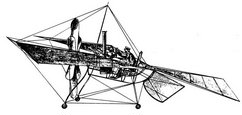
In 1874, a young French sailor piloted Felix du
Temple's monoplane down a ramp and into the air for a few seconds. The
hot-air engine could not sustain the machine in flight. The airplane
apparently had an elevator to control pitch and a rudder for yaw, but
there were no roll
controls.
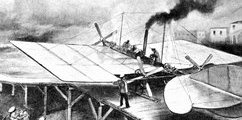
In 1884, Alexander Mozhaisky, a captain in the Russian
Imperial Navy, launched a steam-powered monoplane down a ramp near St.
Petersburg, Russia. It was airborne for 75 to 100 feet (23 to 30 meters), but could not
sustain flight. Nor did Mozhaisky provide any controls. The single
occupant -- I.N. Golubev -- was only along for the (mercifully short)
ride.

In 1890, Clement Ader became the first pilot in
history to take off from level ground. Near Gretz, France, he managed to
fly about 165 feet (50 meters) just a few inches off the ground in his
steam-powered Eole. His 20 horsepower engine, however, could not sustain the machine in flight. The Eole
had only the most rudimentary controls -- Ader planned to use a rudder
to steer right and left and vary the speed of the engine to climb and
descend. There were no roll or pitch controls.
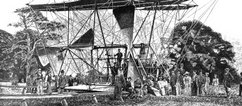
In 1893, Hiram Maxim (the inventor of the machine gun)
built a huge biplane-like test rig with twin propellers, each driven by
an 180 horsepower steam engine. It ran along a 1800-foot (549 meters) straight track
which allowed it to rise only a few inches into the air. In 1894, an
axle broke during a test run, the rig escaped the restraining track, and
it was in free
flight for a few seconds before the crew shut down the engines. It might
have sustained itself in flight -- it certainly had ample power -- but
it had no controls other than two elevators, one forward and one aft.
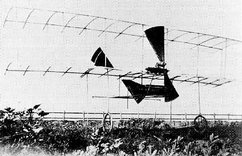
In 1898, Augustus Herring -- co-inventor of the
Chanute - Herring Glider -- attempted to fly a powered version of that
airplane in St. Joseph, Michigan. The compressed-air engine could not
sustain flight; Herring's best hops were no more that 50 to 75 feet (15
to 23 meters). He
had no means of controlling the aircraft other than shifting his body
weight.

German immigrant Gustav Whitehead is said to have
flown briefly on August 14, 1901 in Bridgeport, Connecticut. The
account is controversial; Whitehead claimed wildly successful
flights as early as 1893 and continued until 1903. No plans for any of his
aircraft survive (he claimed to have built over 40), and the existing photos do not
clearly show a means of control.
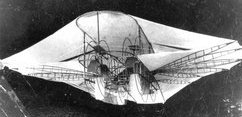
The Reverend Burrell Cannon built the Ezekiel
Airship using the Book of Ezekiel in the Bible as his blueprint. In
the autumn of 1902, it made an unplanned and uncontrolled flight of
about 160 feet (49 meters) while two workers where testing its engine.
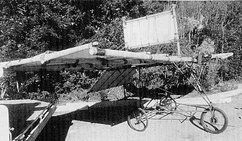
New Zealand farmer Richard Pearse made several hop
flights early in the 20th century. Eyewitnesses recalled these flights
occurred in 1902 and 1903, but Pearse himself wrote that he did not
begin his aerial experiments until 1904. Whatever the dates, Pearse's
drawings show the aircraft lacked a rudder and was not fully
controllable.
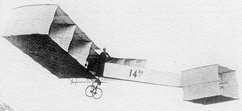
Brazilian Alberto
Santos-Dumont flew his 14-Bis near Paris, France in the fall of
1906. In October, his best flight covered 196 feet (60 meters); in November, he
stretched that to 721 feet (220 meters). Both flights ended when his aircraft entered
a roll that Santos-Dumont could not stop and he decided to land, so
there is some controversy whether or not these were completely
controlled flights. Nonetheless, they are counted as the first
"official" flights in Europe.
|

